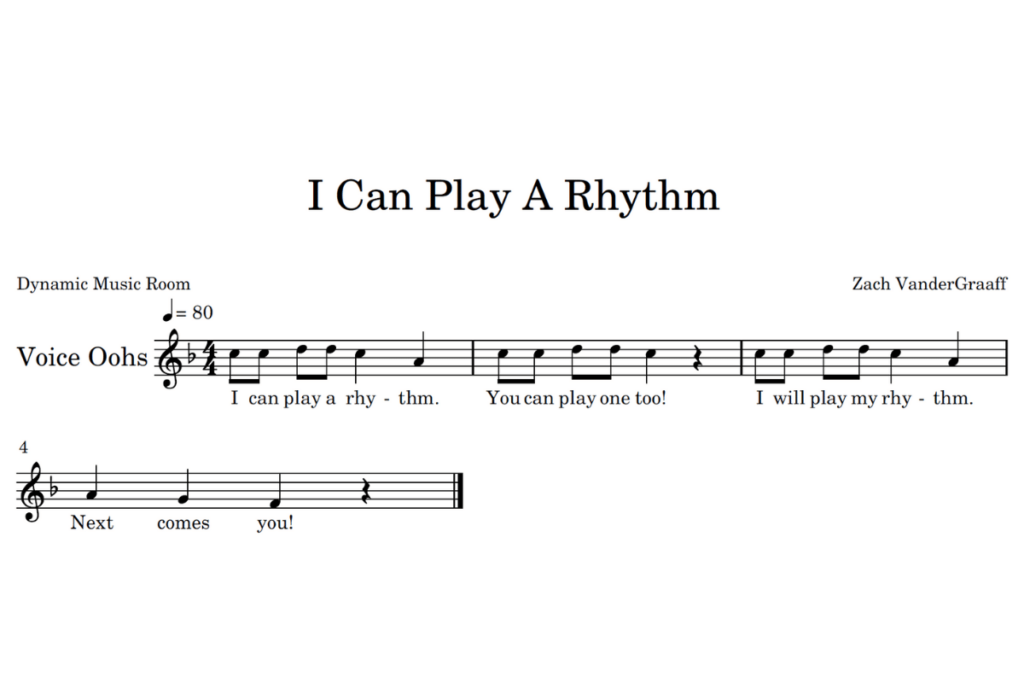The first day of classes can be super awkward, and it’s no different for music classes.
If you’re looking to help students relax around each other and feel more comfortable, you may want to include some icebreakers.
Many of our music activities are natural icebreakers, but if you’re looking for ideas, I’ve got 17 first day of music class icebreakers for all grade levels.
- Hickety Tickety Bumblebee (K-2)
- My Name Is… And I Like… (K-2)
- How Do You Feel About…? Line Game (K-2)
- Statue Game With Questions (K-2)
- I Can Play A Rhythm (K-2)
- Jump In, Jump Out (3-5)
- Never Have I Ever (3-5)
- Note Spinner (3-5)
- Get To Know You Music Bingo (3-5)
- Rhythm Relay (3-5)
- My Favorite Things (Middle)
- My Favorite Song (Middle)
- Common Ground – Music Edition (Middle)
- Music Shuffle Questions (Middle)
- Musical Scavenger Hunt (High School)
- Heads Up! – Musical Instrument Edition (High School)
- Name Game – Adding Names (High School)
Let’s get to it!

Save time with these 60 FREE Music Resources to use in your room right away!
Stop searching the whole internet to find good activities. I’ll help you cut to the chase with my favorite 60 FREE resources.
Table of Contents
First Day Of Music Class Icebreakers For Elementary
Hickety Tickety Bumblebee (K-2)
This song is a simple chant/song with the chance for students to play an instrument and say their name.
I typically use this with preschool and Kindergarten, but it would work well all the way up until second grade (especially if you “bribe” them with some drums).
The words go like this:
Hickety tickety bumblebee
Can you say your name for me?
That’s it!
Students pat the beat (or play on a drum) while saying this part twice.
Then, they say their name, and the class echoes them.
Then, we go back to the chant and repeat it with the next friend in line.
Everyone should get a turn.
My Name Is… And I Like… (K-2)
Here’s another easy chant to do with drums or rhythm sticks.
I do this one with first grade and second grade most often.
It adds another layer to get to know you from the last activity.
Instead of just saying your name, you also need to say something you like!
The words go like this:
One student: My name is… And I like….
Rest of the class: Hi…Nice to see you!
Students take turns saying the first line and fill in the blanks with their name and something they like, such as food, TV, movie, book, summer activities, etc.
The students should also get the chance to play an instrument here.
I often encourage them to play the words (rhythm) to get an idea of how skilled they are at doing so.
How Do You Feel About…? Line Game (K-2)
This is a simple activity I learned when I worked at Camp Tecumseh in Indiana.
It only takes a minute to play.
It’s not strictly related to music, but you can choose different questions related to music.
I also will play this with my older students in elementary (and it’ll even work with older kids too).
Basically, you name things in the world and ask students how they feel about them.
They indicate how they feel with their bodies.
Here are two ways to play this game:
Full Version:
One side of the room is for those who dislike the thing.
One side of the room is for those who love it!
Students move to show how they feel, including anywhere in the middle.
Short Version:
While students are in line, they indicate how they feel about it via quick thumbs up or down (or in between).
Here’s a quick list of things you can ask a student about:
- Pizza
- Recess
- Movies
- TV
- Books
- Star Wars
- The Trolls Movies
- Dogs
- Cats
- Cake
- Ice Cream
- Cheeseburgers
- Music
Get creative with your questions and tailor them for your specific clientele.
Bonus: By answering yourself, you give them ideas of things you like too!
Statue Game With Questions (K-2)
The Statue Game is such a simple game, but kids at this age level love it so much.
Basically, students march around the room when they hear you play the drum.
When the drum stops, they must freeze and make a statue.
I like to ask for different types of statues, and I mix them up by playing faster and slower beats on the drum.
As an icebreaker, add another level to the game by asking only those who qualify to move.
Qualifiers include things that will help you get to know them and each other:
- Have pets
- Are an only child
- Have siblings
- Play video games
- Play a sport
- Like pizza
Take care to avoid picking all qualifiers that may exclude students from low socio-economic homes.
I Can Play A Rhythm (K-2)
I love this song, but I’ll be upfront with you:
It’s not an authentic folk song.
It’s one I made up with my host teacher back during student teaching.
Still, I think it does the job of being catchy.
Of course, you can always replace it with another folk song that uses similar pitches (such as Ickle Ockle Blue Bottle).
Here’s the notation.

After we sing the song, I have students copy my rhythms, but during the first day of school music, I like to use it as an icebreaker.
Instead of rhythm syllables, I say their names!
Kids think it’s pretty cool when you say their names in rhythm (and it gives you practice and helps you learn the names).
Remember! Names aren’t just important for new students to practice either!
Jump In, Jump Out (3-5)
I love this chant, and it’s another one I first learned from my host teacher, Paul Rose.
The words to the chant go like this:
Jump in, jump out.
Turn yourself about.
I said jump in, jump out.
Introduce yourself.
During this chant, students make moves as the words tell them to.
Then, one student steps forward, and the class echoes them as they lead the group.
My name is… (uh-huh!)
And I like… (uh-huh!)
I’m gonna do it! (uh-huh!)
For the rest of my life! (For the rest of your life!)
It’s catchy as all get out, though you may have some who don’t want to be so exposed right away.
I often just let those who want to do it the first day go for it, and those who don’t just do the other parts.
I believe it’s important to never make your students feel uncomfortable by forcing them to perform on their own in front of the class.
And the funny part is, if you do this, over time, almost every single one of your students will end up doing it because they trust you!

Save time with these 60 FREE Music Resources to use in your room right away!
Stop searching the whole internet to find good activities. I’ll help you cut to the chase with my favorite 60 FREE resources.
Never Have I Ever (3-5)
This one is less about music games and more of a true and fun icebreaker.
It’s OK on the first music lesson plans of the year to do some non-music-related icebreakers to get to know each other.
In the game Never Have I Ever, someone says a situation or activity (often funny), and the rest of the group responds by holding up a sign that says, “I Have” or “I Have Never.”
It doesn’t have to be a sign; it can be some other kind of signal too!
Thumbs up or down works (though a little boring).
If they have beanbags of different colors, that may be an idea you want to try too.
Here are some sample Never Have I Ever questions.
Never have I ever…:
- Broken a bone
- Gone skiing
- Slept for 12 hours
- Gone camping
- Goen swimming
- Traveled to another state (or country)
- Played an instrument
- Picked flowers
- Played outside all-day
Note Spinner (3-5)
This is a team music game that you can play at any time of the year, not just at the beginning of the year.
But it works well with your older kids (but only if you’re confident that they know the content from previous years).
The setup is a bit involved, but once you have it, you can use it at other times of the year too!
It’s a fun way to practice note reading and writing.
You’ll need a handful of spinners (think Twister spinners) somewhere between 5-8 in total.
On these spinners, you’ll want to include different pitches on the spinner.
Keep it focused on what the students already know (or on what they should know, and you’re assessing to see what they remember).
Now, split the whole class into teams.
This game is like a race. One person from each team races up to the whiteboard or bulletin board and spins their spinner.
They have to write the correct note on the staff (you’ll also need some blank staffs on the board).
Once they get it right, they go back and tag the next person on their team and sit down.
Alternatively, project a blank staff and hand out fly swatters. Then, they need to simply touch the spot on the staff.
Get To Know You Music Bingo (3-5)
For this game, you have a Bingo card filled with statements related to music.
The goal is for the students to take each card and go around the room, searching for someone who has or fits this quality.
Then, they sign their name on the person’s card.
Play either the first one to Bingo (for a short game) or make them fill up their cards completely (for a longer one).
Qualities on the card may include:
- Plays an instrument
- Has a sibling or cousin in band
- Likes Rock and Roll
- Can name a Beatles song
- Can sing Twinkle Twinkle Little Star
Rhythm Relay (3-5)
This icebreaker game for music classes is similar to the note spinner game from before, except now it’s with rhythm!
Plus, it’s a great way to have
For this, all you need are rhythm flashcards with the matching rhythm content your students should know.
Split the class into teams. One at a time, they must race up to you (if you have a small room, make them make silly moves like crab crawl or hop on one foot).
When they get up to you, they have to read the rhythm the music teachers have up. Then, they go back and sit down.
The team that gets everyone done first wins!
Check out more first day of music class lessons and activities.
First Day Of Music Class Icebreakers For Middle School Students

Note: Many of these work for high school too!
My Favorite Things
In Middle School, I believe all the normal Get-To-Know-You stuff is critical in helping the students feel like you care.
But if there’s any way to also show how much they have in common with the others in their peer group, it’ll go a long way into helping them get to know and feel more comfortable with each other.
This activity comes in two parts.
For the first part, you need to hand out a piece of paper for tracking each student’s list of favorite things, including, but not limited to:
- Favorite food
- Favorite dessert
- Vacation spot
- TV show
- Movie
- Book
- Animal
- Music genre
- Musical artist or band
- Instrument
- Color
The second part of the activity involved them cycling through everyone else in class one at a time.
If the pair has anything in common on the list (or anything the other person likes), they initial each other’s items.
By the end, everyone has a paper of favorite things, and they also have an idea of who else in the class likes the same things!
My Favorite Song
This is less of a first day of music class icebreaker and more of an icebreaker project.
It works really well with middle school general music, though an adapted version of this may be done in performing ensembles as well.
The assignment is simple: Students need to pick one song and present it to the class (or to a small group).
As part of this presentation, they can either make their own poster or create a digital presentation.
It should include:
- Title of song and link to a video
- Lyrics
- Some information about the artist
- Reasons why they like the song
Common Ground – Music Edition
Along the same lines of finding commonalities between people, this common ground activity works great for helping students feel more comfortable with each other.
Split into small groups of three or four; the students are given a simple task:
Create a list of qualities and likes (or dislikes) all your group has in common.
They may all have brown hair, have a pet, or have siblings.
They might all like rap music, piano, or play brass instruments.
To make it a music edition, encourage them to explore the musical preferences and experiences they have.
Music Shuffle Questions
This is my version of a fun, cooperative learning activity for classroom culture building.
If your admin sees you doing something like this, they’ll love it!
But you shouldn’t do it for them.
You should do it because your students will love it too!
Gather a list of questions related to music like:
- What style of music do you like?
- Where do you listen to music the most?
- Do you like fast or slow music better?
- Who is your favorite singer or band?
- What is your favorite instrument?
Get many copies of these questions and hand one each out to each student.
Yes, there will be several with the same question. That’s OK.
Play some upbeat music. Students will mix while the music plays.
When the music stops, they pair up with the nearest person and ask them the question on their paper.
When both are done, they trade papers.
Play some more music and mix again.
Students can’t be partners with the same person twice.
Play as long as you wish and keep answering and trading papers.
First Day Of Music Class Icebreakers For High School

Note: Many of these work for middle school too!
Musical Scavenger Hunt (High School)
Musical scavenger hunt works much like the My Favorite Things activity from the middle school section.
Give students a piece of paper with a list of prompts for music things they like.
After they fill it in, they need to find people who like some of the same things they do.
But there are two main differences:
- You can only have one person initial one item to show the commonality.
- It’s a race to see who finishes their personalized scavenger hunt first.
By high school, they don’t need to spend as much time building confidence in their preferences as in middle school, but they do need some.
Still, the competition piece of it adds another layer of fun (and makes the game shorter).
Heads Up! – Musical Instrument Edition (High School)
Ellen (the talk show host) has been in some hot water lately, but the app game she made was pretty fun.
A version of it makes a great icebreaker for high school music classes (and all classes, really).
The game goes like this:
- One person has a list of items in notecard form they hold up on their head that they can’t see.
- The other person or group needs to get them to guess the word on the index card without saying the actual word (or cheating by using rhyming words). Think of the game, Taboo.
- Everyone they get right is a point for their team. They have one minute to get as many as they can.
For lists, I like to use items like musical instruments or musical artists. It keeps it focused on music, which is good for the first day of music class.
Name Games – Adding Names (High School)
I could have easily put this icebreaker in the elementary or middle school list, but I did this with one of my band camp sections, and they loved it!
For this game, one person (usually me) starts off by saying the person next to their name and an adjective that starts with the same letter as their name.
For example, Penny might be “Perilous Penny.”
Then, Penny has to say her name and make up one for the next person.
- Perilous Penny
- Marvelous Mike
Then, Mike has to say all names before him and make up one for the next person.
- Perilous Penny
- Marvelous Mike
- Speedy Susan
It continues until it goes around the entire group and back to the person who started.
While it may not work with a whole 141-person band, it’s pretty fun to play with groups of 10-30.
Plus, it’s easy enough that your section leaders may be able to run them on their own.

Save time with these 60 FREE Music Resources to use in your room right away!
Stop searching the whole internet to find good activities. I’ll help you cut to the chase with my favorite 60 FREE resources.

